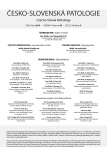A complex diagnostic approach in lymphomas: practical aspect in short case reports
Authors:
Markéta Kalinová; Marcela Mrhalová; Lenka Krsková; Helena Jungbauerová; Alena Kalfusová; Petra Manďáková; Jarmila Čandová; Jan Soukup; Vít Campr; Roman Kodet
Authors‘ workplace:
Lymfomová skupina, Ústav patologie a molekulární medicíny 2. LF UK a FN v Motole, Praha
Published in:
Čes.-slov. Patol., 50, 2014, No. 3, p. 118-126
Category:
Reviews Article
Overview
Complex laboratory investigation is necessary for the diagnosis and relevant classification of lymphomas. The classical histopathological morphology and cytology investigation is essential, but further investigations such as immunohistochemistry and fluorescence in situ hybridization are necessary. It is also important to employ flow cytometry as a method of investigation running synchronously or preceding the histopathological approach. Last but not least, the investigation of nucleic acids in lymphoma by molecular approaches is necessary and has become an everyday practice. Communication between pathologists and clinical colleagues (oncologists, hematologists, internal medicine specialists and radiologists) is very important. We demonstrate the necessity of a complex diagnostic approach to lymphomas and an appropriate interpretation of all laboratory investigations giving examples of eight patients with various types of lymphomas. In some cases, it is impossible to properly diagnose a lymphoma without molecular investigation. Occasionally, the results of the molecular investigation may be misleading and/or may be inaccurately interpreted, leading to an incorrect conclusion. For that reason, it is very important to incorporate all specialized laboratories and their teams under one roof (preferably that of pathology departments), enabling tight and daily cooperation between the specialists. This is the way to reach a precise diagnosis in a majority of cases, as well as how to comply with clinical expectations of properly classified lymphomas for a targeted therapy of patients.
Keywords:
lymphoma – immunohistochemistry – FISH – flow cytometry – PCR – complex diagnosis
Sources
1. van Dongen JJ, Langerak AW, Bruggemann M, et al. Design and standardization of PCR primers and protocols for detection of clonal immunoglobulin and T-cell receptor gene recombinations in suspect lymphoproliferations: report of the BIOMED-2 Concerted Action BMH4-CT98-3936. Leukemia 2003; 17(12): 2257-2317.
2. Nam-Cha SH, San-Millan B, Mollejo M, et al. Light-chain-restricted germinal centres in reactive lymphadenitis: report of eight cases. Histopathology 2008; 52(4): 436-444.
3. van der Velden VH, Szczepanski T, Wijkhuijs JM, et al. Age-related patterns of immunoglobulin and T-cell receptor gene rearrangements in precursor-B-ALL: implications for detection of minimal residual disease. Leukemia 2003; 17(9): 1834-1844.
4. Fried I, Artl M, Cota C, et al. Clinicopathologic and molecular features in cutaneous extranodal natural killer-/T-cell lymphoma, nasal type, with aggressive and indolent course. J Am Acad Dermatol 2014; 70(4): 716-723.
5. Kobayashi T, Tsutsumi Y, Sakamoto N, et al. Double-hit lymphomas constitute a highly aggressive subgroup in diffuse large B-cell lymphomas in the era of rituximab. Jpn J Clin Oncol 2012; 42(11): 1035-1042.
6. Pillai RK, Sathanoori M, Van Oss SB, Swerdlow SH. Double-hit B-cell lymphomas with BCL6 and MYC translocations are aggressive, frequently extranodal lymphomas distinct from BCL2 double-hit B-cell lymphomas. Am J Surg Pathol 2013; 37(3): 323-332.
7. Hoeller S, Zhou Y, Kanagal-Shamanna R, et al. Composite mantle cell lymphoma and chronic lymphocytic leukemia/small lymphocytic lymphoma: a clinicopathologic and molecular study. Hum Pathol 2013; 44(1): 110-121.
8. Krsková-Honzátková L, Čermák J, Sajdová J, et al. Microsatellite instability in hematological malignancies. Leuk Lymphoma 2002; 43(10): 1979-1986.
9. Hussein K, Tiede C, Maecker-Kolhoff B, Kreipe H. Posttransplant lymphoproliferative disorder in pediatric patients. Pathobiology 2013; 80(6): 289-296.
Labels
Anatomical pathology Forensic medical examiner ToxicologyArticle was published in
Czecho-Slovak Pathology

2014 Issue 3
Most read in this issue
- Intestinal metaplasia of the stomach and esophagus: an immunohistochemical study of 60 cases including comparison with normal and inflamed intestinal mucosa
- Soft tissue tumors - the view of the molecular biologist
- Up-to-date experience with the international classification system Bethesda 2010 for thyroid fine-needle aspirate: a review
- A complex diagnostic approach in lymphomas: practical aspect in short case reports
